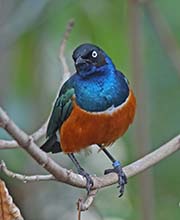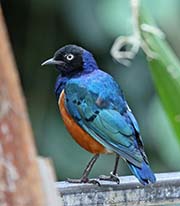Juvenile

Juvenile
02/13/2013 - San Diego Zoo, San Diego, CA
Juvenile
02/13/2013 - San Diego Zoo, San Diego, CA
|

Juvenile Superb Starling being fed
02/13/2013 - San Diego Zoo, San Diego, CA
Juvenile Superb Starling being fed
02/13/2013 - San Diego Zoo, San Diego, CA
|

Juvenile Superb Starling being fed
02/13/2013 - San Diego Zoo, San Diego, CA
Juvenile Superb Starling being fed
02/13/2013 - San Diego Zoo, San Diego, CA
|

02/15/2013 - San Diego Zoo, San Diego, CA
02/15/2013 - San Diego Zoo, San Diego, CA
|
|
|
Adult

03/26/2012 - San Diego Zoo, San Diego, CA
03/26/2012 - San Diego Zoo, San Diego, CA
|

02/13/2013 - San Diego Zoo, San Diego, CA
02/13/2013 - San Diego Zoo, San Diego, CA
|

02/13/2013 - San Diego Zoo, San Diego, CA
02/13/2013 - San Diego Zoo, San Diego, CA
|

09/03/2013 - Bird Kingdom, Niagra Falls, ON, Canada
09/03/2013 - Bird Kingdom, Niagra Falls, ON, Canada
|

12/10/2013 - San Diego Zoo, San Diego, CA
12/10/2013 - San Diego Zoo, San Diego, CA
|
|
Diet:
The Superb Starling is a ground feeder and eats insects, seeds and fruit.
Courtship:
Outside of the breeding season, they will roost together in large flocks.
Courtship includes small jumps on the ground, trailing wings, and an
outstretched neck.
Pairs are believed to be monogamous.
Nesting:
Superb Starlings' nests are bulky and built of grass, leaves, and twigs.
They are usually built in a thorn bush but some are built in cliff holes.
Both the male and female build the nest and share in the incubation and
feeding of the young.
Usually 2-5 blue-green eggs are laid and they are
altricial (helpless) at birth.
Habitat and Range:
The superb starling is found throughout East Africa including Ethiopia,
Somalia, Kenya, and Tanzania.
In some areas they are very common.
They are found in woodlands and thorn bush and agricultural fields.
They are also found near human settlements and urban parks.
Vocalization:
The Superb Starling has a long and loud song consisting of trills and chatters.
At midday it gives a softer song of repeated phrases. There are several harsh calls, the most complex of which is described as "a shrill, screeching skerrrreeee-cherrrroo-tcherreeeeeet."
Plumage/Molt
Superb Starlings do not have an alternate or breeding plumage.
They have a complete annual molt usually completed after the breeding
season.
Migration:
Not a migratory bird.
Tongue/feet:
I am assuming their tongue is like other starlings.
If so, their tongue is medium length and thin and it is
used to manipulate food.
Bibliography:
- http://en.wikipedia.org The Free Encyclopedia, Accessed July, 2012
- http://www.kenyabirds.org.uk/ Kenya Birds, Accessed July, 2012
- http://www.lazoo.org Los Angeles Zoo, CA., Accessed July, 2012
- http://www.paigntonzoo.org.uk Paignton Zoo, England, Accessed July, 2012
- http://www.sfzoo.org San Francisco Zoo, CA, Accessed July, 2012
- http://www.riverbanks.org/subsite/pact/sturnids.pdf The Sturnidae Husbandry Manual and Resource Guide by Greg Bockheim and Susan Congdon, Accessed July, 2012
Top of Page








